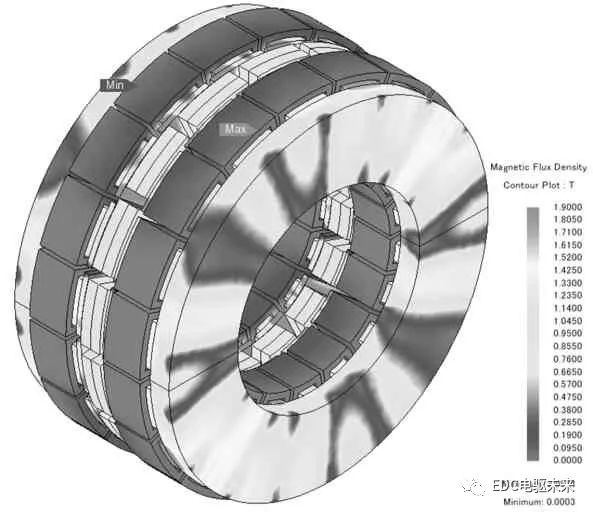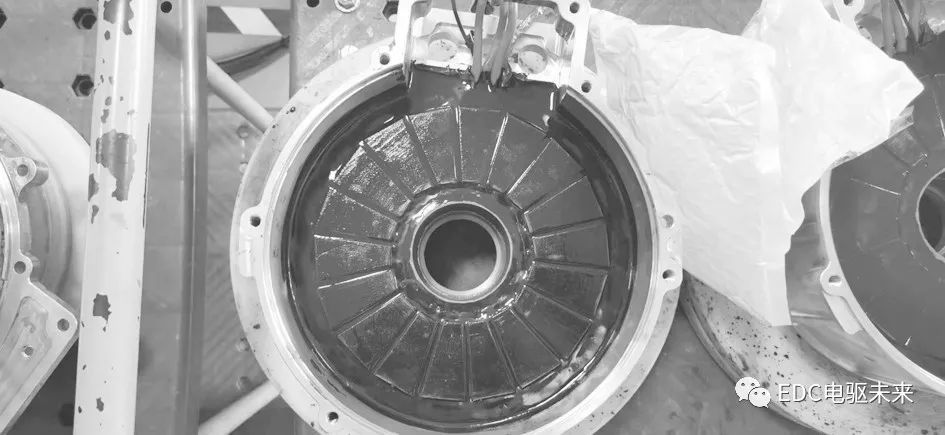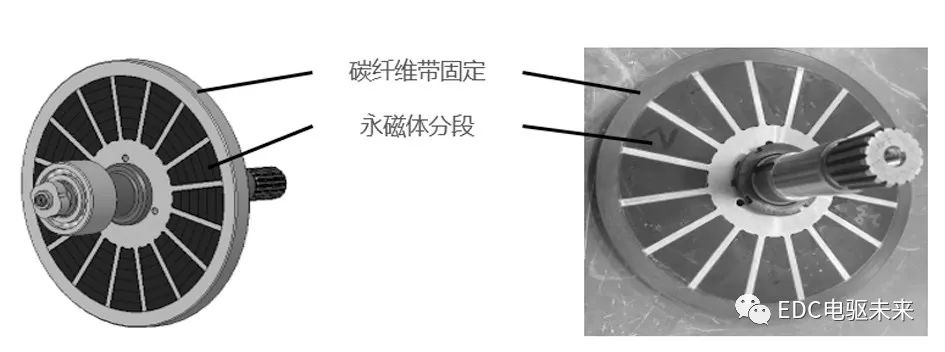A Review of Axial Flux Motor Technology
Axial flux motors (also known as "disc motors") have different magnetic flux paths than ordinary radial motors. The air gap is flat, and the magnetic field direction of the air gap is parallel to the direction of the motor axis. The core technical advantage of the axial flux motor is that the rotating rotor is structurally located on the side of the stator (not inside the stator), and the rotor has a larger diameter size, and torque = force × radius, so it can be under the same force. Get higher torque output. This means that higher torque output can be obtained on the premise of providing the same permanent magnet material and copper wire material. Usually, the design of the new axial flux motor can increase the torque density by more than 30% compared with the design of the traditional radial flux motor.
In the field of automotive electric drives using permanent magnet synchronous motors or induction motors, traditional radial flux motors are being extensively developed for weight and cost optimization, but there is limited room for further improvement in technology. So moving to a completely different motor type might be a good alternative. Because the axial flux motor has the technical characteristics of compact structure, flat and ultra-thin, small size, light weight and high power density, many developers have made great efforts to improve the technology in the past ten years, so that it is gradually suitable for electric motorcycles, airport cranes, etc. cabins, cargo trucks, electric vehicles, and even electric planes.
From the macro perspective of the industry, this paper makes a comprehensive and in-depth investigation and analysis of the new axial flux motor technology and its application from several dimensions such as industrial chain structure, typical products, key technologies, technical challenges, and prospects.
2 Industrial chain structure
The new axial flux motor technology is a forward-looking technology for realizing high specific power and high torque density electric drive systems. The main body of product and technology development is mainly concentrated in a few high-tech innovation enterprises and university research teams. Table 1 is the comprehensive strength statistics table of axial magnetic flux technology research enterprises.
Table 1 Research and innovation enterprises in axial flux motor technology
The intellectual property layout of YASA is the most comprehensive in foreign countries, and the intellectual property layout of Panhu Power is the most comprehensive in China (Figure 1). Especially YASA, the patents it applied in China are all invention patents, and the patents have the highest gold content.
Figure 1 Patent distribution of industry players
3 Typical Products
Phi-Power company has three series of products: Phi-Range, PhE-Range, Rinehart Motion Systemsinverters. Typical product technical parameters are listed in Table 2.
Table 2 Phi-Power's product spectrum
AVID Technology's existing EVO series of standardized axial flux motor products. See Table 3 for specifications. AVID claims that the specific power of its products can reach more than 10 kW/kg.
Table 3 Product Spectrum of AVID Technology
YASA company currently has two main products: YASA 750 and YASA P400. See Table 4 for specifications. YASA's new axial flux motor products are known in the industry for their unique technological innovations. The main technical route is double rotor and single stator, no yoke, segmented armature, and direct oil cooling.
Table 4 YASA company's product spectrum
4 Key Technologies
Axial flux motors have inherent advantages of high power density. At present, the research hotspots (ie technical trends) of this type of motor in the field of new energy vehicles lie in improving efficiency, reducing costs, system integration and NVH improvement. The innovation of axial flux motor technology mainly lies in the structural design, and the technical difficulty lies in thermal management and advanced materials and batch production process. The analysis of the patented technical means of the axial flux motor is shown in Figure 2.
Figure 2 Patented technical means of axial flux motor
Different from the traditional radial flux motor, the axial flux motor includes 5 key technologies, see 4.1~4.5 for details:
4.1 Topological configuration research
According to the number of stators and rotors, the relative positions and the classification of the main magnetic circuit, the basic topological structures can be divided into 4 types, namely single-stator and single-rotor structure, double-stator and single-rotor structure, single-stator double-rotor structure and multi-disc structure. The advantages and disadvantages are shown in Table 5. Appropriate structural topologies should be evaluated based on specific application scenarios, process and cost factors. At present, the automotive electric drive industry conducts a comprehensive analysis of the performance, process feasibility and cost of the topological structures of various types of axial flux motors.
Table 5 Topological structure research of axial flux motor
Note: G stands for "good"; B stands for "bad"; 0 stands for "average"
4.2 3D performance design of new motor
The magnetic flux path of the traditional radial flux motor follows a nonlinear 2D path, while the magnetic flux path of the new axial flux motor is a 3D path. Therefore, the difference between the two must be considered when performing performance simulation design, and models are built according to their respective characteristics. , to improve the accuracy of the model. For the new type of flux motor, 3D multiphysics co-simulation can be used to comprehensively optimize and design the electromagnetic scheme. Continuously improve the design and calculation efficiency of the axial flux motor, and improve the accurate virtual modeling and simulation capabilities. Figure 3 shows the 3D performance design of the axial flux motor.

Figure 3 3D performance design of axial flux motor
4.3 New material application development technology
For example, polyetheretherketone (PEEK) materials with high strength and high insulation properties are developed for the stator frame; high-strength, high thermal conductivity epoxy resin potting and filling materials are developed for heat dissipation and cooling to increase the heat dissipation capacity of the motor body and prevent permanent magnets. For demagnetization at high temperature, as shown in Figure 4, the stator winding of the axial flux motor is encapsulated with epoxy resin; for the stator and rotor cores, high permeability and low loss Sheet Molding Compound (SMC) composite materials, non- Crystalline alloy materials, grain-oriented silicon steel, and SMC materials have the characteristics of easy forming and simple heat treatment process, and are suitable for mass production. At the same time, because of their easy forming characteristics, they can also be used in 3D printing technology, making the motor innovative design more flexible and diverse; High-strength stators and rotors require the development of a carbon fiber winding fixing and strengthening process to cope with the physical properties of the permanent magnets, which have poor tensile strength.

Figure 4 Epoxy potting of axial flux motor stator
4.4 Research on Advanced Manufacturing Process
For example, the rectangular cross-section copper wire, spiral concentrated winding, and multi-pole continuous winding technology are developed for windings, low-loss segmented fixed installation and pole piece demagnetization protection technology are developed for permanent magnets, and yokeless segmented armature splicing is developed for stator cores. , Boltless fixing with end caps, powder metallurgy manufacturing process, and development of automatic assembly technology of stator and rotor, automatic production of flat conductor forming coils, and flexible automatic production line technology for batch production needs. Figure 5 shows the low-loss rotor process.

Figure 5 Low-loss rotor process
4.5 Research on Torque Control and Field Weakening Control Strategy
Research the mathematical model of the stator and rotor coordinate coefficients, build a system simulation model, study the new dual vector model to predict the torque control strategy, reduce the torque ripple, and improve the torque control performance. For the permanent magnet surface-mounted structure of the axial flux motor, The motor's AC and direct axis inductances are equal and small in value, the vector control is difficult, and the magnetic field is easily saturated. A control strategy to improve the field weakening performance is developed.
5 Technical challenges
Although the axial flux motor has technical advantages, and after years of technical research, the industry has mastered the working principle of the new axial flux motor, and has basically made breakthroughs in configuration and structural design, electromagnetic performance design, thermal performance design, calibration and control. Strategies to develop key technologies. But mass adoption is still a long way off, and a number of technical challenges in design and production need to be overcome.
(1) The manufacturing equipment is immature. Due to the lack of research accumulation, the industry does not have a deep understanding of the manufacturing method of axial flux motors, manufacturing equipment is not easy to obtain, and the industry chain is imperfect.
(2) High manufacturing precision is required. Axial motors must maintain a uniform air gap between rotor and stator because the magnetic force is much higher than radial flux motors. Considering that it is also difficult to adjust the air gap during the motor manufacturing process, the manufacturing tolerances of critical components need to be precisely controlled.
(3) Difficulty in thermal management and thermal design. The axial flux motor adopts a sandwich structure. The intermediate stator of the dual-rotor axial flux motor and the intermediate rotor of the dual-stator axial flux motor are difficult to dissipate heat, and the heat capacity is also small due to the high specific power characteristics of the axial flux motor. , and then faced with extremely serious heating problems. It is necessary to adopt new heat dissipation methods of immersion oil cooling, oil-water composite cooling, liquid nitrogen cooling and phase change material cooling, and design extremely complex cooling and sealing structures.
(4) Complex materials and processes lead to high costs. For radial flux motors, the cost of magnets, silicon steel, copper and structural parts, as well as the process cost of mass production, has been recognized by the industry. However, for the new axial flux motor, the industry has insufficient understanding of the new materials and new processes used in its application. The R&D investment cost can be reduced, but the industrialization maturity is low, the cost is high, and there is a high degree of uncertainty in the cost. The biggest obstacle to mass production of new axial flux motors.
6 Summary and Outlook
New axial-flux motors are currently focused on high-end applications on supercars, and have yet to be mass-produced. For example, the Swedish Koenigsegg Regera and Hongqi S9 supercars are equipped with 3 electric motors provided by YASA MOTORS, of which 2 YASA 750 electric motors are located on the left and right half shafts of the rear axle, directly driving the wheels, and the other YASA 400 electric motor is located in the engine. The front end, connected to the engine crankshaft, is used to supplement the power output of the engine.
On July 22, 2021, Mercedes-Benz officially announced a new electrification strategic plan. According to the plan, Mercedes-Benz will launch 3 new pure electric vehicle architectures in 2025: MB.EA will cover all medium and large passenger vehicles, establishing a scalable modular system as the backbone of the future electric product portfolio; AMG.EA will be a dedicated high-performance electric vehicle platform providing solutions for technology- and performance-oriented Mercedes-AMG models; VAN.EA will support electric vans and light commercial vehicles. At the same time, Mercedes-Benz announced the acquisition of YASA, a next-generation electric drive technology company. YASA has become a wholly-owned subsidiary of Mercedes-Benz and will provide electric motors for Mercedes-Benz's AMG.EA pure electric platform. An electric motor with continuous torque output that redefines the driving performance of the future. This is bound to promote the research of new axial flux motor technology for automotive electric drive to a new level.
The new axial flux motor uses less copper, iron, and permanent magnet materials than traditional radial motors under the same power/torque output requirements, so it has higher cost-effectiveness and broad prospects after large quantities. As an emerging technology, axial flux motor can be applied to high-power centralized drive and distributed direct drive electrified chassis scenarios under the condition of flat and limited boundary space in the future. With the in-depth research of the industry, the continuous maturity of technology, the continuous enrichment of application scenarios, and the prominent scale effect, its comprehensive advantages in performance and cost will be transformed into economic benefits.



























 XINDA
XINDA